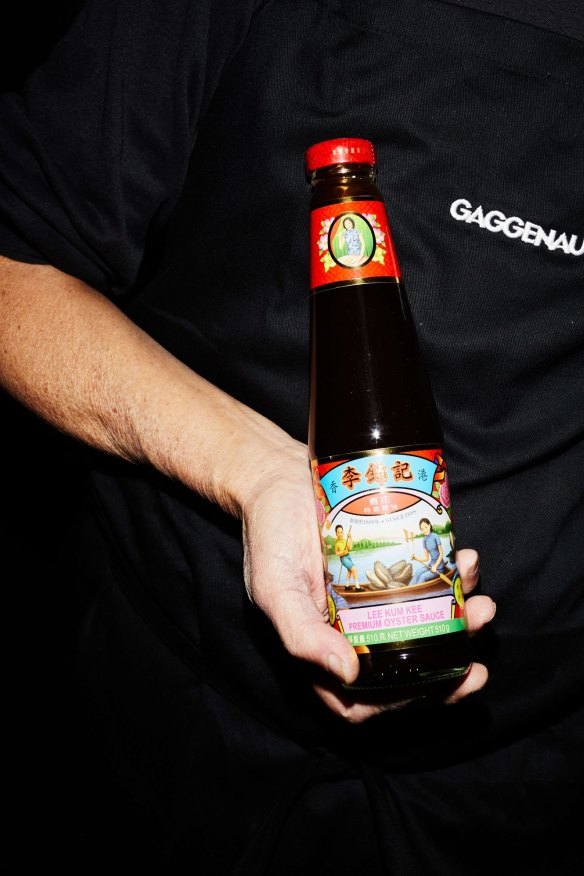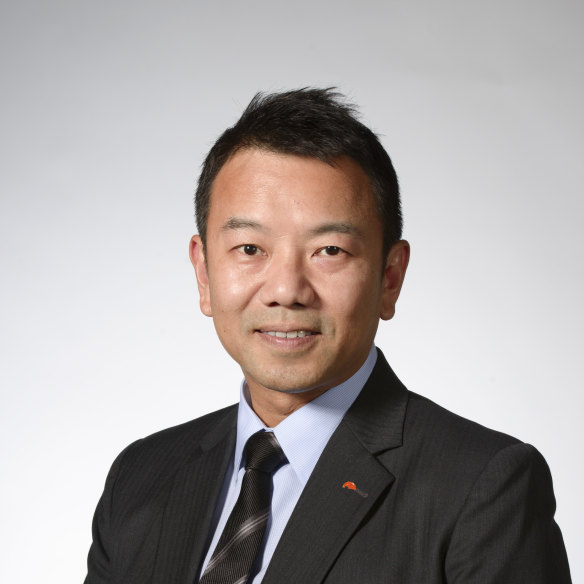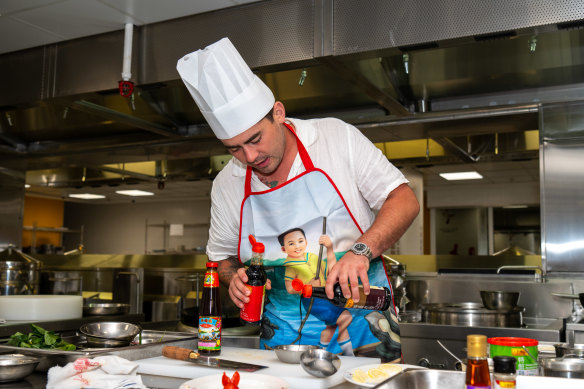
Peek into your pantry or fridge and you’ll likely own at least a few glass-bottled Asian condiments with the rectangular gold label and red lid. But, if asked without any reference or context if you’re familiar with Lee Kum Kee, not everyone will immediately place the Chinese sauce giant that invented oyster sauce.
It’s a problem the multibillion-dollar condiment company is working on.
“We recognise there is a gap,” said Wilson Lam, the Asia-Pacific senior business development manager at Lee Kum Kee and the company’s head of Australia.
“Lots of people know about our brand, but when they’re asked, ‘Do you know about Lee Kum Kee?’, it’s sort of a question mark to them. Until they open up the cabinet, they find out, ‘Oh, I’ve actually got so many Lee Kum Kee products’.”

Oyster sauce, invented by accident by Lee Kum Kee’s founder, is used around the world by chefs and home cooks alike.Credit: Kristoffer Paulsen
The 136-year-old sauce maker’s penetration in some global markets, such as Australia, has arguably exceeded its brand awareness among locals. Lee Kum Kee is said to have been created accidentally. Founded in 1888 by Lee Kum Sheung, the legend goes that he was selling cooked oysters in his tea house when one day he forgot about some oysters simmering in a pot and returned to a thick brown, delicious paste he began selling as oyster sauce.
Despite its fortuitous beginnings, nothing about Lee Kum Kee’s success today has been by chance. That happy accident has spawned a six-generation family empire, one of the most successful in the world, with over 300 sauces, oils, marinades and powders sold across more than 100 markets. It has also expanded into health and wellness, real estate and venture capital investing, making the Lee family, sitting atop an estimated net wealth of $27 billion, one of Hong Kong’s best-known and wealthiest families.
A notable part of their success is owed to governance structures put in place to prevent wayward family members from upending the business, which nearly happened three times in the 1990s to then-patriarch Lee Man Tat, who battled his uncles and brother for control. His youngest son, Sammy – now the group’s executive chairman – and his siblings came up with a dual governance structure to separate family and business matters. Established in 2002, the family council, comprised of seven family members, oversees all family affairs, including succession planning and investments.
As each successive generation joins the business, the sauce company evolves the way it appeals to new consumers. Boomer and Gen X migrants who settled in other parts of the world, Lee Kum Kee’s core market, are likely to have a higher degree of familiarity with and loyalty to the brand. But this isn’t the case with their children, the latest generation, who executives say are cooking less and are more fickle.
“It’ll always be about the top line and bottom line, but there’s more to it. How are you going to hold on to your customer, right?” Lee Kum Kee corporate affairs executive vice president Dodie Hung told this masthead in an exclusive interview.
Gone are the times of splashing on big-budget ad campaigns and calling it a day. “It’s not like that any more. Your social media, your reputation is as good as people’s word of mouth, and what they think about you,” Hung said.
“We’re also looking at how to approach a younger generation. And some of the things that we do, we were doing that even before they become consumers.”

Dodie Hung, Lee Kum Kee’s executive vice president of corporate affairs.
The company’s strategy isn’t so much about flogging products, but selling Asian cuisine as accessible and easy to cook. Products have evolved to meet the demand for convenience. What is effectively a hoisin sauce is presented as a san choy bao “ready sauce” in a packet to help consumers grasp its ease of use. More chefs are reportedly using pre-made sauces as a base for consistency in their cooking, rather than making it from scratch.
Growing the number of products stocked in home pantries and chef kitchens is a target articulated by the company maxim: “Where there are people, there is Lee Kum Kee”. (The mission extends beyond Earth. Lee Kum Kee is an official partner of China’s space industry and the company’s condiments have gone to space 11 times as part of Chinese astronauts’ meals.)
Loading
But the ambition also requires investment in educating consumers. Lee Kum Kee’s encyclopaedic list of products – which includes more than 50 variations of soy sauce, among them “premium”, “superior” and “gold label” that range in quality and are ill-defined – is something of an Achilles heel, particularly in Western markets where uninitiated consumers may be puzzled by the difference between light and dark soy.
When country manager Lam visits Australia, where he spends about a third of his time, he can sometimes be found standing in front of the Asian food aisle in a Coles or Woolworths supermarket to observe incognito how consumers make purchasing decisions. The majority (80 per cent) of Australians seem to recognise the Lee Kum Kee brand, but the same proportion switch brands in front of the shelf, according to research the company commissioned.
It also found Australians cook at home about four or five days of the week, with Asian cuisine making up about half of those days.
Things get a little hazy after that. “When you start asking more, ‘Is this Chinese? Is this Korean?’, there are some question marks,” Lam said. “‘It’s stir-fried, it’s Asian food.’ But stir-fry is many things.”

Former MasterChef contestant Declan Cleary is a brand ambassador for Lee Kum Kee, a first for the company’s Australian operations.
The company has shown a preference for strategic partnerships, collaborations and sponsorships to bridge the gap with Western markets. Shortly after Lam took the helm of the Australian market two years ago, 2023 MasterChef contestant Declan Cleary became Lee Kum Kee’s first brand ambassador outside of Asia. The sauce giant was a key sponsor of the program this year, as contestants used Lee Kum Kee condiments in a mystery box challenge and were whisked to Hong Kong on a surprise trip.
Australians enjoy Asian flavours but don’t always know how to achieve the same results in the kitchen, Cleary said. “There’s definitely an educational piece around how different condiments work,” he said. “Australians are open to diverse flavours but often need a little guidance … [they] are getting there, but there’s still a way to go.”
‘For the family, making money is not necessarily the primary target. It’s actually to grow the [Lee] name, to do it right.’
Dodie Hung, Lee Kum Kee’s corporate affairs executive vice president
Overseas, the Hong Kong-based company has partnered with US ramen chain Kyuramen, Japan-inspired hospitality group Chubby Group and Japanese sushi train chain Sushiro to create exclusive dishes. Lee Kum Kee has also linked up with Australian gelato chain Messina, which has a lesser-known outpost in Hong Kong, to create limited edition oyster sauce, tofu and soy sauce ice-creams (more palatable than you think).
Jumping on the right trends – like chilli – is important, not just for brand perception and getting Gen Z on board, but securing prime shelf space in crucial markets. “We tried for the longest time to get into Walmart and Costco in North America. We couldn’t succeed. Guess what took us there? Sriracha [sauce],” Hung said.
“It sold so well that they would carry our products, and then subsequently things like oyster sauce.”
The new world of anything-on-demand has also created an unexpected enemy of cooking: food delivery. “Everyone’s just gaming,” Hung said of his university-age sons. “They don’t want to go out.”
Trade secrets
Lee Kum Kee is eager to promote the company’s long legacy, but as a family business, is secretive about much. Company executives are happy to confirm that theirs is the world’s top oyster sauce brand, that their soy sauce comfortably sits in the top three in that category, and about 50 per cent of business comes from retail sales, with the other half from food service. But it has never publicly disclosed profit or sales numbers; requests for market share or revenue figures by reporters were either provided on background or politely declined. Executives, particularly the Lee family, rarely make themselves available to media.
The company also believes those closely guarded trade secrets are part of its success and global penetration. A media group hosted by Lee Kum Kee and touring the company’s production facility in Xinhui, China, were not permitted to enter the factories themselves. The company will not disclose seemingly more innocuous details, like how many oysters go into a bottle of oyster sauce.

Tanks of soy sauce at Lee Kum Kee’s production facility in Xinhui, China. The tanks span 1.33 million square metres.
“The only thing we can divulge is the sauce business has been growing every year, even through the toughest times,” Hung said. “We don’t [share figures] because we’re not a public company … we’re a private company.”
The sixth generation, which has begun entering the family business, brings strengths in social media and marketing. Rules have been set in place to guard against nepotism. Younger members of the Lee family must have at least three years’ experience at an unrelated company before joining the business, which has a special development program for family members. Newcomers are also permitted to sit in board meetings of the venture capital business, Happiness Capital.
As a global business, the company is branching out beyond condiments to build its line of food products, which already includes rice, noodles and canned abalone. This month, the Hong Kong market will launch Boston lobster bisque with rice as a convenience meal positioned deliberately at the premium end of frozen food.
Loading
“If we do like ‘Lee Kum Kee Har Gow’, every Tom, Dick and Harry is doing that,” Hung said. “If you slap the Lee Kum Kee brand on, it’s supposed to be a bit premium.” But not overly so, or people won’t see the brand as accessible.
Another company maxim is “100 minus 1 equals zero”. “For the family, making money is not necessarily the primary target,” said Hung. “It’s actually to grow the [Lee] name, to do it right.”
The reporter travelled to Hong Kong to tour the company’s headquarters and production facilities as a guest of Lee Kum Kee.
The Business Briefing newsletter delivers major stories, exclusive coverage and expert opinion. Sign up to get it every weekday morning.



























